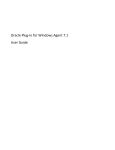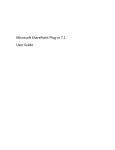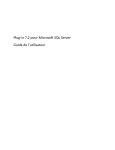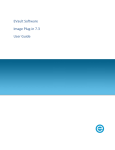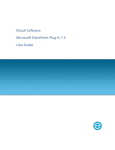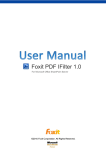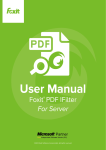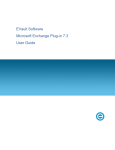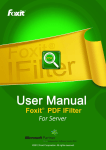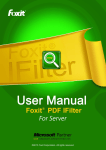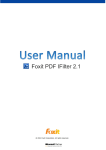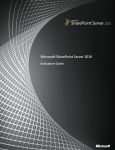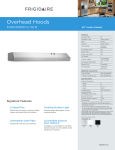Download Microsoft SQL Server User Guide
Transcript
Microsoft SharePoint 2010/2013 Backup and Restore Guide 7.30 Copyright SharePoint Backup and Restore Guide 7.30 Revision: This manual has been created for Version 7.30 (October 2013). Software Version: 7.30 2013 The software manufacturer makes no representations or warranties with respect to the contents hereof and specifically disclaims any implied warranties of merchantability or fitness for any particular purpose. Furthermore, the software manufacturer reserves the right to revise this publication and to make changes from time to time in the content hereof without obligation of the software manufacturer to notify any person of such revision of changes. All companies, names and data used in examples herein are fictitious unless otherwise noted. No part of this document may be reproduced, transmitted, transcribed, stored in a retrieval System or translated into any language including computer language, in any form or by any means electronic, mechanic, magnetic, optical, chemical or otherwise without prior written permission. All other products or company names mentioned in this document are trademarks or registered trademarks of their respective owners. Acknowledgements: Two encryption methods, DES and TripleDES, include cryptographic software written by Eric Young. The Windows versions of these algorithms also include software written by Tim Hudson. Bruce Schneier designed Blowfish encryption. "Part of the software embedded in this product is gSOAP software. Portions created by gSOAP are Copyright (C) 20012006 Robert A. van Engelen, Genivia inc. All Rights Reserved. THE SOFTWARE IN THIS PRODUCT WAS IN PART PROVIDED BY GENIVIA INC AND ANY EXPRESS OR IMPLIED WARRANTIES, INCLUDING, BUT NOT LIMITED TO, THE IMPLIED WARRANTIES OF MERCHANTABILITY AND FITNESS FOR A PARTICULAR PURPOSE ARE DISCLAIMED. IN NO EVENT SHALL THE AUTHOR BE LIABLE FOR ANY DIRECT, INDIRECT, INCIDENTAL, SPECIAL, EXEMPLARY, OR CONSEQUENTIAL DAMAGES (INCLUDING, BUT NOT LIMITED TO, PROCUREMENT OF SUBSTITUTE GOODS OR SERVICES; LOSS OF USE, DATA, OR PROFITS; OR BUSINESS INTERRUPTION) HOWEVER CAUSED AND ON ANY THEORY OF LIABILITY, WHETHER IN CONTRACT, STRICT LIABILITY, OR TORT (INCLUDING NEGLIGENCE OR OTHERWISE) ARISING IN ANY WAY OUT OF THE USE OF THIS SOFTWARE, EVEN IF ADVISED OF THE POSSIBILITY OF SUCH DAMAGE." The Agent, Agent Console, and Vault applications have the added encryption option of 128/256 bit AES (Advanced Encryption Standard). Advanced Encryption Standard algorithm (named Rijndael, pronounced “Rain Doll”) was developed by cryptographers Dr. Joan Daemen and Dr. Vincent Rijmen. This algorithm was chosen by the National Institute of Standards and Technology (NIST) of the U.S. Department of Commerce to be the new Federal Information Processing Standard (FIPS). See:http://csrc.nist.gov/encryption/aes/round2/r2report.pdf for details. The Agent and Vault applications have the added security feature of an over the wire encryption method. Contents Microsoft SharePoint 2010/2013 Backup and Restore Guide 7.30 Contents 1 Introduction to Backing up and Restoring SharePoint ........................................................ 1 1.1 Overview – Backing up SharePoint 2010/2013 ............................................................... 1 1.2 Overview – Granular Restore of SharePoint 2010/2013 ................................................ 1 1.3 Features........................................................................................................................... 2 1.4 About This and Other Related Guides............................................................................. 2 1.5 Release Notes and Online Help ....................................................................................... 3 2 Backing up SharePoint Data Content ................................................................................. 4 3 Granular Restores of SharePoint Data Content .................................................................. 5 3.1 Setting up a Safeset for Granular Restore of SharePoint 2010/2013 ............................. 5 3.1.1 Permissions Required.............................................................................................. 5 3.1.2 Setting up a Safeset for Granular Restore with Windows Agent Console .............. 5 3.1.3 Setting up a Safeset for Granular Restore with Web Agent Console ................... 10 3.2 Restoring with the SharePoint Granular Restore Application ...................................... 14 3.2.1 Prerequisites for Granular Restores...................................................................... 14 3.2.2 Limitations for Granular Restores ......................................................................... 14 3.2.3 Attaching the SharePoint Content Database ........................................................ 14 3.2.4 Steps to Restore from a SharePoint Database with BLOB Storage Enabled ......... 19 Steps to Restore from a SharePoint Database with a Mounted BLOB Store ...................... 19 Steps to Restore from a Copy of the Mounted BLOB Store ................................................ 19 4 i 3.2.5 How to Browse to your Restore Selections .......................................................... 20 3.2.6 How to Search within your Loaded Items ............................................................. 20 3.2.7 Search using Filters ............................................................................................... 22 3.2.8 Making your Restore Selections ........................................................................... 23 3.2.9 Restoring SharePoint Content to the SharePoint Server ...................................... 25 3.2.10 Restoring SharePoint Content – Save to Disk ....................................................... 26 3.2.11 Browse Log Files .................................................................................................... 27 3.2.12 Site Collection Restore Managed Path - Detected Conflicts ................................. 28 SharePoint 2010/2013 Backup and Disaster Recovery Protection ..................................... 29 Contents Microsoft SharePoint 2010/2013 Backup and Restore Guide 7.30 4.1 Overview - SharePoint DR for a Single Server Farm...................................................... 29 4.2 Preliminary Steps for Backing up SQL Server/SharePoint ............................................. 29 4.3 Backing up the Single Server Farm - SQL Server/SharePoint (One Job)........................ 30 4.4 Restoring the Single Server Farm - SQL Server/SharePoint Together (One Job) .......... 30 4.5 Backing up the Single Server Farm - SQL Server/SharePoint Separately (Two Jobs) .... 31 4.6 Restoring the Single Server Farm - SQL Server/SharePoint Separately (Two Jobs) ...... 31 4.7 SharePoint Disaster Recovery (DR) for a Single Server Standalone System ................. 32 5 ii 4.7.1 Backing up the System - SQL Server Express/SharePoint ..................................... 32 4.7.2 Restoring the System - SQL Server Express/SharePoint ....................................... 32 Appendix: Installing the Granular Restore for SharePoint Application .............................. 33 Introduction to Backing up and Restoring SharePoint 1 Microsoft SharePoint 2010/2013 Backup and Restore Guide 7.30 Introduction to Backing up and Restoring SharePoint This chapter provides an overview on how to protect your SharePoint 2010/2013 databases. It also outlines how to perform restores at a granular level such as Site Collections, Web Sites, Lists, Libraries, Folders, List Items, or Documents with the new Granular Restore for Microsoft SharePoint application. This manual also describes how to share a SharePoint/SQL DR backup safeset to enable the use of the new Granular Restore for Microsoft SharePoint application. The new Microsoft Granular Restore for SharePoint application eliminates the need to run SharePoint backups with the SharePoint Plug-in. A backup safeset created with the SQL Plug-in will allow you to perform granular restores, while a Bare Metal Restore (BMR) backup safeset will not allow you perform granular restores. The “Agent for Microsoft Windows User’s Guide” has information on installation of the Agent and Plug-ins, and Agent configuration. The “Agent Console Operations Guide” has detailed information on Agents, Backups, Jobs, Scheduling, Safesets, Options, Logs, Security and Troubleshooting. 1.1 Overview – Backing up SharePoint 2010/2013 Backing up a SharePoint 2010/2013 database is accomplished by backing up the SQL database that holds the contents of the SharePoint application. This requires creating a backup Job with the SQL Plug-in or a BMR type backup. Refer to section 4 for the steps on how to back up your SQL/SharePoint system. The “Microsoft SQL Server Plug-in User’s Guide” has information on installation of the SQL Plug-in and how to create a SQL VSS DR backup for content databases. Use the SQL Plug-in guide workflows for reference. Note: The SharePoint Plug-in is still used for the older SharePoint versions, SharePoint 2007, WSS 3.0, and SharePoint 2003. 1.2 Overview – Granular Restore of SharePoint 2010/2013 Restoring SharePoint 2010/2013 content data is accomplished in a two step manner. First, the SharePoint/SQL DR safeset must be shared. This is done by running a restore Job through Web Agent Console or Windows Agent Console. Once the DR safeset is shared, the Granular Restore application is used to restore Site Collections, Web Sites, Lists, Libraries, Folders, List Items, or Documents. The SharePoint Granular Restore Application allows for browsing the SharePoint/SQL DR safeset and making multiple restore selection(s). Restores can be to original or alternate location. The Granular Restore application eliminates the need to have additional SharePoint Jobs, thus reducing your storage costs and backup demands. Page 1 Introduction to Backing up and Restoring SharePoint Microsoft SharePoint 2010/2013 Backup and Restore Guide 7.30 Refer to section 3 for the steps on how to restore SharePoint items. 1.3 Features • Perform restores at a granular level such as Site Collections, Web Sites, Lists, Libraries, Folders, List Items, or Documents. • Restore multiple sites or files from one Job. • Restore to original or alternate location. • The new Granular Restore for SharePoint application eliminates the need to run SharePoint backups with the SharePoint Plug-in as done with previous SharePoint versions. 1.4 About This and Other Related Guides Use this guide in conjunction with other manuals that describe Agent Console, Agents, and Plug-ins. Agent Console Operations Guide • Installing the main Agent Console software (GUI) • Using the Agent Console GUI – Workspace, Agents, Agent Configurations, Jobs, Safesets, Catalogs and Log files • Performing backups • Report Logs • Data Security • Troubleshooting and Command-Line Interface Windows Agent User Guide • Agent for Windows Installation • Using the Agent for backup and recovery • Cluster Support Plug-in Microsoft SQL Server Plug-in User Guide • SQL Server Plug-in Installation • SQL Server backup and recovery Page 2 Introduction to Backing up and Restoring SharePoint 1.5 Microsoft SharePoint 2010/2013 Backup and Restore Guide 7.30 Release Notes and Online Help Release notes provide “up to the minute” information about the released product. Release notes contain descriptions of new features, supported platforms, fixes, known issues, and product support. Release notes are available from your service provider. Web Agent Console provides online help, some of which is similar to the contents of this User Guide. There is also context-sensitive help for many Windows Agent Console screens. Press F1 to view the help. Page 3 Backing up 2 Microsoft SharePoint 2010/2013 Backup and Restore Guide 7.30 Backing up SharePoint Data Content Backing up a SharePoint 2010/2013 database is accomplished by backing up the SQL database that holds the contents of the SharePoint application. This requires creating a VSS DR backup Job with the SQL Plug-in. Refer to section 4 for the steps on how to back up your SQL/SharePoint system. The backup safeset that contains your SharePoint Data Contents can be restored as part of a disaster recovery (DR). You can also restore individual items such as Site Collections, Web Sites, Lists, Libraries, Folders, List Items, or Documents by creating a restore Job “share” of the backup safeset and running the Granular Restore for Microsoft SharePoint application. The “Microsoft SQL Server Plug-in User’s Guide” has information on installation of the SQL Plug-in and how to create a SharePoint/SQL DR backup. Windows or SQL Administrator rights are required. Use the SQL Plug-in guide workflows for reference. Note: The Granular Restore for Microsoft SharePoint application cannot be used to perform restores at a granular level from a BMR safeset. Page 4 Granular Restores of SharePoint Data Content 3 Microsoft SharePoint 2010/2013 Backup and Restore Guide 7.30 Granular Restores of SharePoint Data Content 3.1 Setting up a Safeset for Granular Restore of SharePoint 2010/2013 Restoring SharePoint 2010/2013 content is accomplished in a two step manner. First, the SharePoint/SQL safeset must be shared. This is done by running a restore Job through Web Agent Console or Windows Agent Console. Once the safeset is shared, the Granular Restore application is used to restore individual sites, individual files, or documents. The SharePoint Granular Restore Application allows for browsing the SharePoint/SQL safeset and making multiple restore selection(s). Restores can be to the original or an alternate location. 3.1.1 Permissions Required For Restore: 3.1.2 • Local Administrator to the SharePoint Server • An account added to the SQL Security Logins with Public and SYSAdmin server roles • Local Administrator on the SQL server Setting up a Safeset for Granular Restore with Windows Agent Console To set up an SQL safeset share using Windows Agent Console: Page 5 1. Select the Agent and Job you wish to restore from. 2. Right-Click and select Restore. This will launch the Restore Wizard. Here you are asked to “Choose how to restore”. Granular Restores of SharePoint Data Content 3. Page 6 Microsoft SharePoint 2010/2013 Backup and Restore Guide 7.30 Select Granular restore of SharePoint 2010/2013 data (if applicable). Click Next. Granular Restores of SharePoint Data Content 4. Select a source from which to restore: The source safeset location will be displayed (by default) from the safeset backup (usually from a vault). You can select a different safeset to restore. If the backup was encrypted, you must enter and confirm the password. 5. Advanced Share Options will allow you to provide sharing options for the data source. To access the advanced share options, click the Advanced Share Options button. 6. Page 7 Microsoft SharePoint 2010/2013 Backup and Restore Guide 7.30 • Idle time: Enter the number of minutes that the share can be idle before it is automatically unshared (value can be from 2 to 180 minutes). The default idle time is five minutes. • Bandwidth Option: Use all available bandwidth is checked by default. Click OK when your selection is complete. Granular Restores of SharePoint Data Content 7. Page 8 Microsoft SharePoint 2010/2013 Backup and Restore Guide 7.30 The Restore Job Share summary page is displayed for your review. Click Share to create the share and display the share path. Copy the share path so that you can paste it into the Granular Restore application. To copy the share path, click once to highlight the path, then right-click and select copy to copy the path to your clipboard. Granular Restores of SharePoint Data Content Page 9 Microsoft SharePoint 2010/2013 Backup and Restore Guide 7.30 Granular Restores of SharePoint Data Content 3.1.3 Microsoft SharePoint 2010/2013 Backup and Restore Guide 7.30 Setting up a Safeset for Granular Restore with Web Agent Console To set up an SQL safeset share using Web Agent Console: 1. Select the Agent and Job you wish to restore from. 2. Click the Run Restore button. This will launch the Restore From a Backup Wizard. Here you are asked to “Choose how to restore”. Select the Granular restore of SharePoint 2010/2013 radio button. Click Next. 3. Select a backup version: You can select a different safeset to restore, or you can enter a safeset number in the textbox. If the backup was encrypted, you must enter and confirm the password. Page 10 Granular Restores of SharePoint Data Content 4. Page 11 Microsoft SharePoint 2010/2013 Backup and Restore Guide 7.30 Advanced Share Options allow you to provide sharing options for the data source. To access those options, click the Advanced Share Options button. • Idle time: Enter the number of minutes that the share can be idle before it is automatically unshared (value can be from 2 to 180 minutes). The default idle time is 5 minutes. • Bandwidth Option: Use all available bandwidth is checked by default. Granular Restores of SharePoint Data Content Microsoft SharePoint 2010/2013 Backup and Restore Guide 7.30 5. Click OK to save the Advanced Share Options. Click Next when your selection is complete. 6. The Restore Job Share summary page is displayed for your review. Click Share to create the share and display its path. Copy the share path so that you can paste it into the Granular Restore application. Click once to highlight the path, then right-click and chose copy to copy the path to your clipboard. Page 12 Granular Restores of SharePoint Data Content Microsoft SharePoint 2010/2013 Backup and Restore Guide 7.30 You can now use the share with the Granular Restore application. Page 13 Granular Restores of SharePoint Data Content 3.2 3.2.1 Microsoft SharePoint 2010/2013 Backup and Restore Guide 7.30 Restoring with the SharePoint Granular Restore Application Prerequisites for Granular Restores A safeset containing the SharePoint content database must be shared and accessible. This is done through Web or Windows Agent Console as outlined in section 3.1. The SharePoint Granular Restore application can only be installed on a SharePoint server. You can install the Granular Restore application without SharePoint installed, but it will not run even for alternate location restores. 3.2.2 Limitations for Granular Restores The application can restore files up to 2 GB in size. This is a Microsoft limit: SharePoint files cannot be larger than 2 GB. A SharePoint backup can only be restored to the same version of SharePoint that was used to create the backup safeset. You cannot attach a SharePoint 2010 database on a SharePoint 2013 system, and you cannot attach a SharePoint 2013 database on a SharePoint 2010 system. This includes any service packs applied to the SharePoint system. Restore from a SharePoint database without a Service Pack to the same version of a SharePoint system with a Service Pack, or vice versa, is not supported due to a Microsoft limitation. A restore to an environment that has an older SQL Server version than was used during the creation of the backup safeset is not supported. A restore to an environment that has the same or newer SQL Server version as that of the backup is supported. Cross-farm databases are not supported. Note: If you select a Transaction Log only backup safeset when running a restore using the “Granular Restore of SharePoint” option, the share created will contain the last full backup (.mdf, .ldf, and .ndf) and transaction (.bak) log files. The .bak files are not processed or read when using the Granular Restore for SharePoint application. Note: Should you incur an error when mounting a database with the message "An error occurred during an operation. Please check the log files for details, and try the operation again." The log file can be located in: C:\ProgramData\GranularRecoveryTool\logs. 3.2.3 Attaching the SharePoint Content Database Before you can choose items to restore, the Granular Restore application must connect to a SharePoint content database. When you launch the SharePoint Granular Restore application, it will automatically launch the Attach SharePoint Content Database wizard. Page 14 Granular Restores of SharePoint Data Content Microsoft SharePoint 2010/2013 Backup and Restore Guide 7.30 You are prompted to paste the share path for the safeset share that contains the content database. This is the path that you pasted to your clipboard when creating the share with Web or Windows Agent Console. 1. Post the share path and click Add. The Select Database to Attach window will pop up. The Content database will already be populated within this window. 2. Click OK to confirm your selection. 3. Click Next to proceed. Page 15 Granular Restores of SharePoint Data Content Microsoft SharePoint 2010/2013 Backup and Restore Guide 7.30 Note: If your SharePoint database has BLOB storage enabled, please refer to section 3.2.4 for detailed instructions for restore from BLOB storage. Page 16 Granular Restores of SharePoint Data Content Microsoft SharePoint 2010/2013 Backup and Restore Guide 7.30 The Connecting to SQL Server page is displayed. The Connecting to SQL Server page prompts you to select an SQL Server instance and authenticate your access credentials. 4. Click the Search radio button if you wish to search for the SQL Server instance name. You can search for Local Instances or Network Instances. If you click the Search radio button, a list of the available SQL Instances will be generated. You may use the default Windows authentication or use SQL Server authentication. For SQL Server authentication, you must enter the appropriate Username and Password. 5. When you have selected the SQL instance you wish to use, test the connection by clicking on the Test Connection button. If the connection is verified, you will see the message “Connection to SQL Instance successful”. 6. Click Attach to attach the content database. The content database will now be attached and the items will be loaded for use with Granular Restore application. This process may take a few minutes, depending on the size of the database. Page 17 Granular Restores of SharePoint Data Content Microsoft SharePoint 2010/2013 Backup and Restore Guide 7.30 7. A summary page provides information about the attachment of the content database. Click Close to close this page and proceed with the granular restore of your SharePoint content. Page 18 Granular Restores of SharePoint Data Content 3.2.4 Microsoft SharePoint 2010/2013 Backup and Restore Guide 7.30 Steps to Restore from a SharePoint Database with BLOB Storage Enabled There are two scenarios for restoring from a SharePoint database with BLOB storage enabled. The first scenario is when you want to restore from the SharePoint database, not the BLOB store, even though BLOB storage was enabled during the creation of the safeset backup. The limitation of this restore is that you cannot restore documents greater than the size threshold that was set when the BLOB store was enabled. The default value for this threshold is 60KB. Items greater than this threshold are stored in the BLOB store and cannot be restored with this method. Items less than this threshold can be restored from the SharePoint database. The second scenario is if you want to restore from the BLOB store. The second scenario will allow you to restore documents greater than the size threshold that was set when your BLOB store was enabled. This method requires you to copy the Blob Storage folder from the mounted location to the local disk on SQL server and restore from that copy. Steps to Restore from a SharePoint Database with a Mounted BLOB Store 1. 2. 3. 4. 5. 6. 7. 8. Attach the SharePoint Content Database by clicking the Add button and browsing to the safest share. Click Open when you have made your selection. Check the “Database has remote BLOB storage” checkbox. Locate the BLOB storage “filestream.hdr” file and copy it to your clipboard. This file is located within your RestoreMount folder. Create a new folder such as “BLOB hdr file copy” (you can use any name) and paste the “filestream.hdr” file into that folder. Add all permissions or “Users” to the new folder. Copy the new folder path to your clipboard and paste that path into the “Path to copy of BLOB store or filestream.hdr” field. Click Next Steps to Restore from a Copy of the Mounted BLOB Store 1. 2. 3. 4. 5. Attach the SharePoint Content Database by clicking the Add button and browsing to the safest share. Click Open when you have made your selection. Check the “Database has remote BLOB storage” checkbox. Locate the BLOB storage. This file is located within your RestoreMount folder. Create a new folder such as “BLOB copy” (you can use any name) and copy the BLOB storage into that folder. 6. Add all permissions or “Users” to the new folder. 7. Copy the new folder path to your clipboard and paste that path into the “Path to copy of BLOB store or filestream.hdr” field. 8. Click Next Note: Only filestream BLOBs are supported. Page 19 Granular Restores of SharePoint Data Content 3.2.5 Microsoft SharePoint 2010/2013 Backup and Restore Guide 7.30 How to Browse to your Restore Selections Once you have attached a content database, you can browse the Site Collections and make your restore selections. You can browse the hierarchy of the content database either with the navigation buttons or with the Go To Children (sub directory) arrow on the right hand side of the window (if available and not grayed out). Clicking one of the navigation buttons will take you directly to that specific level of items. Navigation buttons include: Site Collections • Web Sites • Lists • Libraries • Folders • List Items • Documents If you have used the Go To Children arrow(s) to navigate into the content database, a breadcrumb trail shows your navigation path. You can click on the breadcrumb links to navigate directly back to a previous level. • Note: The default number of items to load is 100 at a time. You can continue to load more items by clicking the Load Next … button. You can also enter the number of items you would like to Load Next in the field provided. 3.2.6 How to Search within your Loaded Items The search functions can help locate the items you wish to restore. This can be especially useful when you have a large number of items loaded. You can find specific items or narrow the number of items displayed. Page 20 Granular Restores of SharePoint Data Content When items are loaded, you can search the following: Site Collections by: Title • Site Collection • Author • Date Modified • Web Sites by: • • • • • Site Collection Title URL Author Created Date Lists by: Web Site • List • Author • Created Date • Libraries by: Web Site • Library • Author • Created Date • Folders by: Web Site • List • Folder/List Item/Document • List Items by: Web Site • List • List Item • Page 21 Microsoft SharePoint 2010/2013 Backup and Restore Guide 7.30 Granular Restores of SharePoint Data Content Microsoft SharePoint 2010/2013 Backup and Restore Guide 7.30 Documents by: Location • Document • File Size (Bytes) • Author • Created Date Note: You can search within all the documents by pressing the Documents button on the ribbon. • 3.2.7 Search using Filters You can refine and narrow your search by using the funnel filters. Click on the funnel you wish to use and select from the available filter options. You can filter by date by clicking on the calendar icon and making your date selection. Page 22 Granular Restores of SharePoint Data Content 3.2.8 Microsoft SharePoint 2010/2013 Backup and Restore Guide 7.30 Making your Restore Selections Once you have located what you want to restore, you can select an item by clicking on it or you can select multiple items by selecting the checkboxes to the left of each item. Page 23 Granular Restores of SharePoint Data Content Microsoft SharePoint 2010/2013 Backup and Restore Guide 7.30 You can select all of the items displayed by clicking the small triangle to the left of the WebSite heading (above the selection checkboxes). You can also select a range of items by clicking one item and then clicking another item while holding shift. You can select individual items by holding Ctrl while making your selections. Note: When you make a selection that has sub directories (Children), all items contained within the sub directory are automatically selected for restore as well (recursively). Note: You cannot restore a root website from the Web Site view. The Restore button will be disabled (grayed out). You must use the Site Collections view to run a root level website restore. Page 24 Granular Restores of SharePoint Data Content 3.2.9 Microsoft SharePoint 2010/2013 Backup and Restore Guide 7.30 Restoring SharePoint Content to the SharePoint Server 1. After selecting data to restore, click the “Restore” Action icon. Here you can review your restore selections as well as their restore destinations. The default restore destination is to restore to the original location. You can restore to an alternate location within the SharePoint server farm by clicking the Browse button and selecting a location from the list of available locations displayed. Available alternate restore locations will be to the same level within the SharePoint Server. I.e. List items can be restored to an alternate site at the List level. 2. Click the Restore button to run the restore. 3. If the same file exists in the restore location, you will be prompted with the message “Some data will be overwritten. Do you want to proceed?” Click Yes to start the restore. The Restore Progress Information will be displayed. Here you can monitor the restore process as it restores the individual items. Page 25 Granular Restores of SharePoint Data Content Microsoft SharePoint 2010/2013 Backup and Restore Guide 7.30 Note: If you click the Cancel button during a restore, the item that is currently being restored will be completely restored (this may take some time depending on the size of the item). Subsequent items in the list will be cancelled and will not be restored. 3.2.10 Restoring SharePoint Content – Save to Disk The Save to Disk option is available at the documents level only. Note that this level does include file extensions which can be restored other than documents. 1. If you wish to save to disk (rather than to the SharePoint Server), select your items for restore and click Save to Disk. Here you can select which version of a document is to be restored. 2. When your version selection is complete, click the Save button. Page 26 Granular Restores of SharePoint Data Content Microsoft SharePoint 2010/2013 Backup and Restore Guide 7.30 3. Browse to the folder location where you want to save the document or click Make New Folder to create a folder for your restore destination. 4. Click OK when you have made your selection. 5. Click Restore to run the restore. 3.2.11 Browse Log Files It can be useful to review log files if you have encountered an error or failure. To view Log files, click the Browse button on the Restore ribbon. Page 27 Granular Restores of SharePoint Data Content 3.2.12 Microsoft SharePoint 2010/2013 Backup and Restore Guide 7.30 Site Collection Restore Managed Path - Detected Conflicts If you are restoring a Site Collection and the path no longer exists or there is a conflict, you must resolve the conflict. A screen will appear: “The required managed path is missing on the target web application. Please choose the Site Collection Prefix and enter the New Site Collection Name (if applicable).” Select the Site Collection Prefix from the dropdown list and then enter a new valid site collection name in the field provided. Click Ok when completed. Page 28 SharePoint 2010/2013 Backup and Disaster Recovery Protection 4 Microsoft SharePoint 2010/2013 Backup and Restore Guide 7.30 SharePoint 2010/2013 Backup and Disaster Recovery Protection 4.1 Overview - SharePoint DR for a Single Server Farm For disaster recovery (DR) of a Single Server Farm, the simplest method of protecting your SharePoint Server is to create a Bare Metal Restore (BMR) type backup and then restore with the System Restore (SR) application. The BMR backup captures your entire system, including the operating system, applications, system state, and data. The System Restore (SR) application is used to restore your system from the BMR backup safeset. There are two scenarios for SQL Server/SharePoint DR for a Single Server Farm, outlined below: • The first scenario will back up your entire SQL Server/SharePoint with a single BMR Job. That one Job is the only Job that is required for restore. Note: The Granular Restore for Microsoft SharePoint application cannot be used to perform restores at a granular level from a BMR safeset. • 4.2 The second scenario can be used if you are already backing up your SQL Server database SharePoint content with the SQL Plug-in (for use with the Granular Restore for Microsoft SharePoint application). In this case, you can reduce your backup size and costs by excluding the SQL database files from your BMR backup. For DR restore, you will first need to restore the system using your BMR Job, and then restore the SQL Server/SharePoint with the SQL Plug-in Job. Preliminary Steps for Backing up SQL Server/SharePoint Note: The following preliminary steps are required for SharePoint application level consistency. 1. Run the following commands to make sure the SharePoint related VSS Writers are registered and available. For SharePoint 2010 and 2013 • stsadm-o registerwsswriter • stsadm-o osearch-action start For SharePoint 2010 • stsadm-o spsearch-action start –farmserviceaccount<DOMAIN\name> farmservicepassword <password> 2. Make sure the startup type of the following services is set to automatic and that the services are started. Page 29 SharePoint 2010/2013 Backup and Disaster Recovery Protection Microsoft SharePoint 2010/2013 Backup and Restore Guide 7.30 For SharePoint 2010 and 2013 • SQL Server VSS Writer • Application Host Helper Service For SharePoint 2010 • SharePoint 2010 VSS Writer • SharePoint Server Search 14 • SharePoint Foundation Search V4 For SharePoint 2013 • SharePoint VSS Writer (By default, the SharePoint 2013 VSS Writer service is not automatically started.) • SharePoint Server Search 15 • SharePoint Foundation 2013 Administration service (By default, this service is not started on standalone installations.) Note for backing up SharePoint 2013 single server farm with SQL 2012 on Windows 2012: A Microsoft hotfix is required to be installed for proper backup operations. A Reboot is required after installation. The hotfix can be obtained from Microsoft at: http://support.microsoft.com/kb/2807849. To download the hotfix, an email address must be provided. 4.3 Backing up the Single Server Farm - SQL Server/SharePoint (One Job) 1. Prepare for the backup by completing the preliminary steps outlined in section 4.2. 2. Using Windows or Web Agent Console, select the Agent on the SQL machine that contains the SharePoint Server. 3. Create and run a Bare Metal Restore (BMR) backup Job for the entire SharePoint server. 4.4 Restoring the Single Server Farm - SQL Server/SharePoint Together (One Job) 1. Prepare a clean machine with no operating system installed. 2. Start the machine, booting from the SR application, and select the BMR Job with the SharePoint Server backup. 3. Drag and drop all of the appropriate volumes to the new environment. 4. Verify the SR Restore Plan steps and start the restore. 5. Repair any drivers or devices via the repair wizard (if necessary). Make sure they are all showing green status. Page 30 SharePoint 2010/2013 Backup and Disaster Recovery Protection Microsoft SharePoint 2010/2013 Backup and Restore Guide 7.30 6. Reboot the machine. Note: If your applications (SQL/SharePoint) are installed in different volumes, it is recommended to restore to the same number of volumes. 4.5 Backing up the Single Server Farm - SQL Server/SharePoint Separately (Two Jobs) 1. Prepare for the backup by completing the preliminary steps outlined in section 4.2. 2. Using Windows or Web Agent Console, select the Agent on the SQL machine with the SharePoint server. 3. Create a Bare Metal Restore (BMR) backup Job, backing up the entire SharePoint server, excluding the SQL database files. Note: If you exclude the Data folder (that contains database files) from your BMR Job and create a SQL Job, make sure to run the Jobs at the same time or as close to the same time as possible. Note: You cannot exclude the database files named AppMng_Service_DB_<GUID> (SharePoint 2010) or Application_Registry_Service_DB_<GUID> (SharePoint 2013) from your BMR Job. 4. Run the BMR backup. 5. If a SQL Job has not already been created, create a backup Job of the SQL database using the SQL Server Plug-in (see the SQL Plug-in Guide for further details). If you would like to have SharePoint granular restore ability, create a SQL Job for the content databases for the sites. Microsoft Tip: Run “Get-SPContentDatabase -site http://contoso.com” to locate all content databases for a SharePoint site. 6. Run the SQL backup. Note: It is strongly recommended that you back up the system databases (master, model and msdb) in one SQL Job. Then back up any other (user) databases in one or more other Jobs. 4.6 Restoring the Single Server Farm - SQL Server/SharePoint Separately (Two Jobs) 1. Prepare a clean machine with no operating system installed. 2. Start the machine, booting from the SR application, and select the BMR Job with the SharePoint backup. 3. Drag and drop all of the appropriate volumes to the new environment. 4. Verify the SR Restore Plan steps and start the restore. 5. Repair any drivers or devices via the repair wizard (if necessary). Make sure they are all showing green status. 6. Reboot the machine. 7. Restore the SQL database using the SQL Server Plug-in. Page 31 SharePoint 2010/2013 Backup and Disaster Recovery Protection Microsoft SharePoint 2010/2013 Backup and Restore Guide 7.30 Note: For a disaster recovery scenario, you must restore the Master Database first, by itself. Then you can restore the other system databases. Note: If your applications (SQL/SharePoint) are installed in different volumes, it is recommended to restore to the same number of volumes. 4.7 SharePoint Disaster Recovery (DR) for a Single Server Standalone System For disaster recovery (DR) of a SharePoint Single Server Standalone system, you can create a BMR type backup and then restore with the System Restore (SR) application. Note: SharePoint single server standalone by default uses Microsoft SQL Server Express which is not supported for use with the Granular Restore for Microsoft SharePoint application. 4.7.1 Backing up the System - SQL Server Express/SharePoint 1. Prepare for the backup by completing the preliminary steps outlined in section 4.2. 2. Using Windows or Web Agent Console, select the Agent on the SQL machine that contains the SharePoint Server. 3. Create and run a Bare Metal Restore (BMR) backup Job for the entire SharePoint server. 4.7.2 Restoring the System - SQL Server Express/SharePoint 1. Prepare a clean machine with no operating system installed. 2. Start the machine, booting from the SR application, and select the BMR Job for the SharePoint DR backup. 3. Drag and drop all of the appropriate volumes to the new environment. 4. Verify the SR Restore Plan steps and start the restore. 5. Repair any drivers or devices via the repair wizard (if necessary). Make sure they are all showing green status. 6. Reboot the machine. Note: If your applications (SQL/SharePoint) are installed in different volumes, it is recommended to restore to the same number of volumes. Page 32 Installing the Granular Restore for SharePoint Application 5 Microsoft SharePoint 2010/2013 Backup and Restore Guide 7.30 Appendix: Installing the Granular Restore for SharePoint Application The Granular Restore for SharePoint application must be installed where the SharePoint application is installed. This is required whether you are restoring to the original SharePoint location or to an alternate location. 1. To install the Granular Restore for SharePoint application, launch the install kit. 2. If your system does not have the required .NET 4.0, you will be prompted to install it. If .NET 4.0 is already installed, you will not see this prompt. 3. Click Install. 4. The Granular Restore for SharePoint Welcome screen will appear. Click Next to continue. 5. Click “I Accept” to accept the license agreement. Click Next to continue. 6. The installation destination screen will appear. Click Next to continue or click Change to select an alternative location. 7. Click Install. Click Finish when the installation completes. You may also check the Launch Granular Restore for SharePoint checkbox if you wish to run the application immediately. Page 33





































